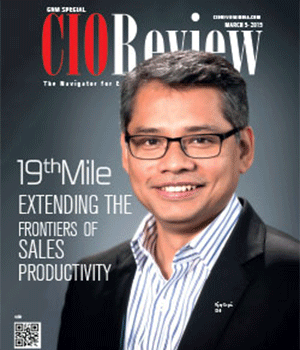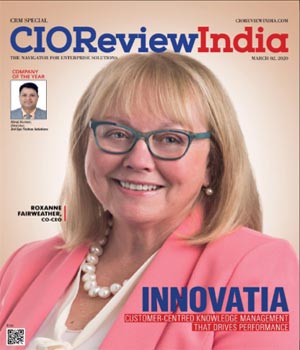
Transforming Customer Experience with Information and Technology
Jiunn Tan, CIO, Ascend One | Wednesday, 28 December 2016, 12:38 IST
 In the era of media explosion, consumers are being bombarded by messages and advertisements 24/7 across all media and channels. Companies that could cut through the clutter by delivering excellent customer experience would be rewarded. The path to achieving customer experience nirvana however, would require a customer focused ecosystem that integrates technology, data and analytics across all customer facing touchpoints. As a result, CIOs are in the enviable position to positively influence customer experience and it behooves us to share this vision with other C-level executives and obtain buy-in on why investment in such an ecosystem would elevate business performance.
In the era of media explosion, consumers are being bombarded by messages and advertisements 24/7 across all media and channels. Companies that could cut through the clutter by delivering excellent customer experience would be rewarded. The path to achieving customer experience nirvana however, would require a customer focused ecosystem that integrates technology, data and analytics across all customer facing touchpoints. As a result, CIOs are in the enviable position to positively influence customer experience and it behooves us to share this vision with other C-level executives and obtain buy-in on why investment in such an ecosystem would elevate business performance.
Prospecting — Ground zero of customer experience management
One would typically not associate prospecting with customer experience but first impression does count! What better way to attract consumers who are still in the awareness stage of the purchase funnel by offering them an environment to conduct their research at their own pace where there is no high pressure sales involved. Establishing an online community, where prospects and/or customers alike could interact, ask questions and receive suggestions from other users, is also an effective way to foster a sense of camaraderie between your clients while empowering them to self-serve. Relationships with customers could be further strengthened by showcasing them in company events via Instagram photos or by inviting them to blog about your products and featuring their posts in the community. This is an effective way to turn them into your raving fans. Make social share buttons easily accessible so that it is easy for them to share with their friends and families.
The online community is also the place to collect information on prospects for future re-marketing purposes. Better yet, turn it into an “incubator” for prospects that are not quite ready to make the leap yet—nourish the relationship with relevant content at the appropriate moment to keep them coming back for more. User feedback, both positive and negative, needs to be monitored closely using analytic capabilities such as natural language processing and responses to them must be timely. Another area of opportunity would be to harvest suggestions and potentially incorporated them into new product features or even new products ideas.
Customer Interaction Gateways
The gateways whereby your customers interact with you are probably the most critical aspects of this ecosystem. These days, when making a phone call, we can expect to be routed to an interactive voice response unit but after entering your account number and taken through a series of questions/prompts, isn’t it frustrating the very first question the agent asked is the information you just provided to the system? Good customer experience (both for the customer and the agent) calls for a phone system to recognize the caller’s number and to utilize the data captured to inform the agent via a dashboard. The dashboard should contain recent customer activities and any reminders to assist the agent with servicing the customer (note: where appropriate, this same dashboard can be repurposed at the Point-of-Sales to assist agents that check out customers at retail locations).
Intelligent call routing is another requirement. For example, a simple logic to route an unrecognized phone number, which is more likely to be from a prospect, to a sales oriented group and a recognized number to service oriented groups could enhance customer experience. More advanced logic like recognizing preferred customers and routing them to a special servicing unit can also be accomplished once such capability is in place.
The other gateway is your website. With a plethora of consumer devices in use today, your website is perhaps the singularly most important customer touchpoint that technology can impact. Is your website responsively designed such that its look and feel is consistent regardless of whether it is accessed on smartphones, tablets or desktops? Are the content and graphics optimized for viewing on smartphones —aside from aesthetic, is load time a consideration? Usability is another factor. Is your site intuitive for first time users to navigate and find what they are looking for? Is it efficient for repeat users to get to their destination (how many clicks does it take them to get there)? Your customers would not and could not buy your products/services if it is hard to find them. With the continued growth in mobile commerce, do you have a mobile app that simplifies the purchase experience? Does it store order history to make re-ordering easy? Anything you can do to reduce friction during the purchase process would result in more spending.
Outgoing Customer Communications
Outgoing communications to clients regardless of transactional, promotional or informational nature is another important element of customer experience management. While delivering the right message to the right customer at the right time is a cliché, it is also a fact. With the onslaught of communications and advertising, your customers want to be treated as an individual and not a faceless mass. No one wants to receive mass communications that does not pertain to his/her needs — relevancy matters. This is evident from documented improvements in response and click through rates between customized and generic content.
Build a data hub to capture client demographics, purchase history across channels, contact cadence and communications preference and leverage advanced analytics to synthesize the data. Once you have the data, you could easily generate actionable customer insights such as product recommendations and/or relevant promotions using predictive analytics and automatically delivered them via a communications architecture that segments by customer type, recency and frequency of purchase (or lack of) while also factoring in timing and number of recent contacts already made to the customer.
Creating a top notched customer experience requires careful management of all customer touchpoints. It takes hard work and the company that works most diligently at it will ultimately be rewarded. While nothing can replace the face-to-face interactions, information and technology can play a major role by reducing the number of friction points. Especially in this era of digitization, CIOs need to be bold and continue to push for the use of analytics, data and technology to delight your customers. To other executives, embrace technology to pleasantly surprise your customers and your business will thank you for it.
CIO Viewpoint
Measuring Machine Learning Bias
By Dr. Supriya Ranjan Mitra, Director, IT at Schneider Electric
Customer Analytics - The Cornerstone of CRM...
By Yagnesh Parikh, CTO, ICICI Securities
Why is the Digital Customer Experience Truly...
By Sven Gerjets, Former CIO, Time Warner Cable
CXO Insights
What's Wrong with Current CRMs and Future of...
By Satish Patil, PhD (Founder and CEO), Mitibase Technologies Pvt Ltd
Top Five Customer Service Predictions For 2021
By Suman Reddy, MD, Pegasystems India
Work 2021: Prepare For A Flexible Future









